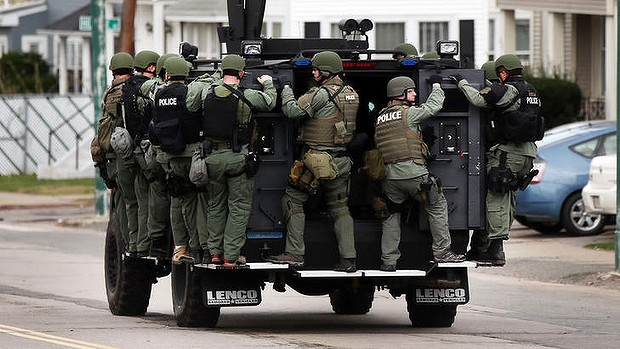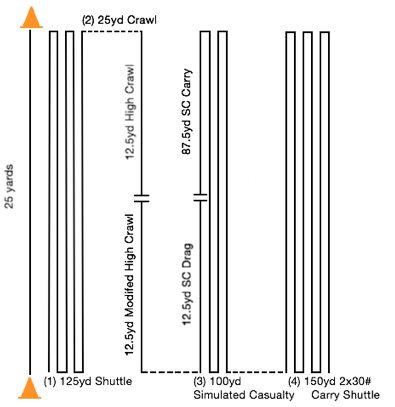By Adam Scott, MS, CSCS
In a previous survey, we asked for feedback in regards to SWAT Selection from our LE community – A big thanks to everyone who replied. We received input from SWAT teams in Florida, Illinois, California, New Jersey, Texas, and a few others.
Almost every SWAT selection we received was different, but when we broke them down they all had a few key characteristics.
Key Characteristics
1. The Cooper Test is still king. In one form or another, every unit uses parts of it – 1.5-mile run, 300m sprint, sit-ups, push-ups and vertical jump. By far the most popular events were the sprint, push-ups and sit-ups.
2. Strength/Power is queen. We found that most SWAT selections put a premium on strength and power. To test these attributes departments used bench presses, heavy carries, short sprints, agility tests, weighted runs (with up to 180#), and even grip tests.
3. Pull-Ups. Weighted or un-weighted – every unit had some pull-up requirement. For the unweighted pull-ups we saw minimums between 5 and 12, and weighted (25-40#) minimums were between 2 and 5.
4. Aerobic Fitness. It may not be a priority during the initial fitness test, but aerobic fitness (especially running) is big component of SWAT training programs. From what we heard, most SWAT candidates will be expected to run between 3-5 miles a day during their training.
5. Water Confidence / Swimming. While it wasn’t in every program it was in more than we expected. To pass candidates had to swim between 50-200m in tactical uniform and tread for 5-15 minutes.
6. Obstacle Course Events. Like the overall requirements, none of these were the same. Some were weighted, others were not; we saw walls, dummies, nets, stairs, sledges, ropes, tires, you name it. Distances varied from 1/4 of a mile to 3/4 of a mile (including obstacles), but over 75% of departments had some form or obstacle event.
7. Testing Procedures. Most selection tests or screeners took place during a single day event. Typically candidates had to perform the physical tests in the morning (with between 1 and 5 minutes between events). Candidates who passed the physical tests would then progress to the shooting assessments in the afternoon (usually handgun and shotgun). Candidates who passed both tests were then invited to attend the unit’s SWAT school or training program. These typically lasted between 1 and 3 weeks.
Developing Training Standards
1. The Cooper Test. Probably the most consistent way to set our SWAT physical standards are to pair them with the SWAT shooting standards – 90%. For the Cooper Test 90% equals:
– 1.5mile Run < 11mins. 38 sec.
– Push-Ups > 38
– Sit-Ups > 42
– 300m Sprint < 48 sec.
– Vertical Leap > 23 inches
These standards are higher than most departments, but we want our athletes over-prepared. Plus, from the feedback we received candidates who struggle with minimums will have difficulty completing training.
2. Strength and Power. Obviously we can’t cover everything, but ideally we will train our athletes for the three most common measures:
– Bench Press > BW+25%
– 25# Weighted Pull-Up > 5 reps
– 100m Sprint < 14 sec.
3. Aerobic Fitness. Part of the aerobic standard is captured in the Cooper Test 1.5 mile run, but we also want our SWAT athlete prepared for the longer runs and even longer training days of SWAT school. For this we expect them to be able to comfortably run 5 miles in under 45:00 (and still be ready to train).
4. Water Confidence. Although we did see this in a surprisingly large number of selections (20%) we would likely not have a training standard for it. For most of the programs swimming and water confidence were skill components rather than fitness attributes.
5. Obstacle Course. This standard is the most difficult to develop because of the variety of tasks involved. We recently developed a training program for the USMC Combat Fitness Test (CFT) and designed a modified version of their Maneuver Under Fire (MANUF) event. For this event the marines complete a 400-yard course which includes shuttles sprints, crawling, a simulated casualty drag, a simulated casualty carry and weighted shuttles.
Our SWAT program will likely include a weighted (25# vest) standard similar to this test. Here is a link to the video and a diagram of our USMC test.
What’s next?
We take the common characteristics, apply our standards and develop a training program. Based on what we now know and the variety of requirements we are looking at a 6-8 week training plan. Preparing for the Cooper Test will be a major part of the plan, but we will also focus on building the specific strength, endurance, agility and work capacity.
Questions, Comments, Feedback? Email coach@mtntactical.com
You Might Also Like MTI’s SWAT SELECTION Training Plan


